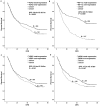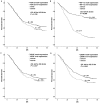HIF-1 alpha overexpression correlates with poor overall survival and disease-free survival in gastric cancer patients post-gastrectomy
- PMID: 24614305
- PMCID: PMC3948685
- DOI: 10.1371/journal.pone.0090678
HIF-1 alpha overexpression correlates with poor overall survival and disease-free survival in gastric cancer patients post-gastrectomy
Abstract
Background: Overall, gastric cancer prognosis remains poor. Detailed characterization of molecular markers that govern gastric cancer pathogenesis is warranted to establish innovative therapeutic options. HIF-1α overexpression has been linked to poor gastric cancer prognosis. However, though researched for years, the prognostic role of HIF-1α in gastric cancer is still controversial. Hence, the objective of the present study was to analyze the prognostic values of HIF-1α, TGF-β, VEGF and pERK1/2 in gastric cancer patients following gastrectomy.
Methods: This study included 446 patients with confirmed gastric cancer who underwent gastrectomy in a single Chinese Cancer Center between 2005 and 2006. Clinicopathologic features, as well as immunohistochemical analysis of TGF-β, HIF-1α, VEGF and pERK1/2 were determined. Long-term survival of these patients was analyzed using univariate and multivariate analyses.
Results: HIF-1α overexpression was more frequent in patients with hepatic metastases (71.6% versus 43.0% in those without hepatic metastases, P = 0.000, χ2 = 23.086) and more frequent in patients with peritoneum cavity metastasis (62.3% versus 43.0% in those without such metastasis, P = 0.000, χ2 = 13.691). In univariate analysis, patients with HIF-1α overexpression had a shorter disease-free survival (DFS) and overall survival (OS) than patients with weak-expression (DFS: NA VS. 16.8 m, P = 0.000, χ2 = 74.937; OS: NA VS. 25.5 m, P = 0.000, χ2 = 90.594). Importantly, HIF-1α overexpression was a promising prognostic marker for poor survival by multivariate analysis (DFS: HR 2.766, 95%CI 2.136-2.583, P = 0.000; OS: HR 3.529, 95%CI 2.663-4.667, P = 0.000).
Conclusions: HIF-1α overexpression could be considered a useful independent prognostic biomarker in gastric cancer after gastrectomy, and is correlated to both a poor overall survival and disease-free survival in these patients. HIF-1α expression can be used to stratify patients at higher risk for poor prognosis, and is potentially an important therapeutic target in gastric cancer patients.
Conflict of interest statement
Figures



References
-
- Jemal A, Bray F, Center MM, Ferlay J, Ward E, et al. (2011) Global cancer statistics. CA Cancer J Clin 61(2): 69–90 - PubMed
-
- Kamangar F, Dores GM, Anderson WF (2006) Patterns of cancer incidence, mortality, and prevalence across five continents: defining priorities to reduce cancer disparities in different geographic regions of the world. J Clin Oncol 24(14): 2137–50 - PubMed
Publication types
MeSH terms
Substances
LinkOut - more resources
Full Text Sources
Other Literature Sources
Medical
Research Materials
Miscellaneous

